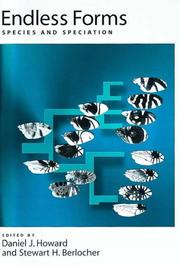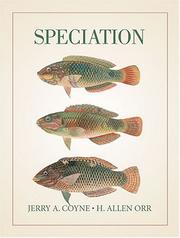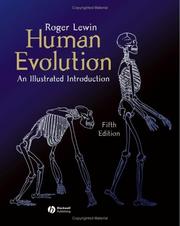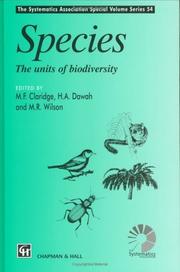| Listing 1 - 10 of 23 | << page >> |
Sort by
|
Book
ISBN: 0140169776 9780140169775 Year: 1994 Publisher: London : Penguin Books,
Abstract | Keywords | Export | Availability | Bookmark
 Loading...
Loading...Choose an application
- Reference Manager
- EndNote
- RefWorks (Direct export to RefWorks)
575.858 --- #WPLT:syst --- Species. Speciation --- 575.858 Species. Speciation

ISBN: 0195109007 0195109015 9780195109009 9780195109016 Year: 1998 Publisher: Oxford Oxford University Press
Abstract | Keywords | Export | Availability | Bookmark
 Loading...
Loading...Choose an application
- Reference Manager
- EndNote
- RefWorks (Direct export to RefWorks)
Speciation is one of the great themes of evolutionary biology. This work offers information on species concepts, modes of speciation, the nature of reproductive barriers, the forces that drive divergence of populations, the genetic control of reproductive isolation, and the role played by hybrid zones and hybridization in speciation.
Evolution. Phylogeny --- Species. --- 575.858 --- Species. Speciation --- 575.858 Species. Speciation --- Species --- Speciation (Biology) --- Biology --- Genetics --- Hybridization --- Organisms

ISBN: 0878930892 0878930914 9780878930890 9780878930913 Year: 2004 Publisher: Sunderland, Mass. Sinauer
Abstract | Keywords | Export | Availability | Bookmark
 Loading...
Loading...Choose an application
- Reference Manager
- EndNote
- RefWorks (Direct export to RefWorks)
Evolution. Phylogeny --- Species --- 575.858 --- Species. Speciation --- Species. --- 575.858 Species. Speciation --- Speciation (Biology) --- Biology --- Genetics --- Hybridization --- Organisms
Book
ISBN: 9060692004 Year: 1974 Publisher: Rotterdam Lemniscaat
Abstract | Keywords | Export | Availability | Bookmark
 Loading...
Loading...Choose an application
- Reference Manager
- EndNote
- RefWorks (Direct export to RefWorks)
Developmental psychology --- #WPLT:syst --- 575.1 --- genetica --- erfelijkheidsleer --- 572 --- 575.2 --- 575.858 --- 159.922.3 --- 159.95 --- 599.2 --- Erfelijkheidsleer --- Intelligentie --- Menselijke gelijkheid --- Antropologie --- Variation --- Species. Speciation --- 575.858 Species. Speciation --- 575.2 Variation
Dissertation
ISBN: 9789086491810 Year: 2008 Publisher: Leuven Katholieke Universiteit Leuven. Faculteit Wetenschappen
Abstract | Keywords | Export | Availability | Bookmark
 Loading...
Loading...Choose an application
- Reference Manager
- EndNote
- RefWorks (Direct export to RefWorks)
Balsaminaceae zijn een familie van één of meerjarige kruidachtige planten die gekenmerkt worden door een enorme bloemmorfologische diversiteit. Hoewel de familie meer dan 1000 soorten omvat, worden er slechts twee genera erkend: het monotypische genus Hydrocera en het soortenrijke genus Impatiens. Met een soortenaantal dat de 1000 ruimschoots overschrijdt, behoort Impatiens tot de top 20 van de meest soortenrijke bloemplantengenera. De vlijtige liesjes vertegenwoordigen ca. 0,4% van alle tot nu toe beschreven bloemplanten, wat wil zeggen dat één soort op 250 een Impatiens is. Het evolutionair succes van Impatiens staat in schril contrast met het monospecifieke zustergenus Hydrocera en tot op heden blijft het een raadsel hoe de enorme diversiteit binnen Impatiens tot stand gekomen is. Vegetatief zijn Impatiens soorten immers erg gelijkend, steeds met een semi-succulente stengel en enkelvoudige, getande bladeren. Verder vertonen zowel het vruchtbeginsel als de meeldraden amper morfologische variatie. Soorten binnen het genus onderscheiden zich voornamelijk in kelk- en kroonbladmorfologie. Impatiens werd in het verleden steeds als een taxonomisch moeilijke groep beschouwd waarin verwantschapsrelaties amper konden ontrafeld worden. Verschillende klassieke systematici hebben immers tal van pogingen ondernomen om de intragenerische relaties binnen het genus te begrijpen, maar steeds werd er vastgesteld dat men een artificiële classificatie bekomen had. Met de opkomst van moleculair systematische technieken werd het echter mogelijk om voorheen onoplosbare fylogenetische vraagstukken aan te pakken. Dit doctoraatsonderzoek had als doel om de verwantschapsrelaties in de Balsaminaceae op te helderen door gebruik te maken van een gecombineerde morfologische en moleculaire aanpak. Met behulp van het chloroplast atpB-rbcL gen en de nucleaire ImpDEF1 en ImpDEF2 merkers werd een sterk ondersteunde en goed opgeloste stamboom van de Balsaminaceae bekomen. Op basis van deze stamboom kan men aannemen dat Impatiens ontstaan is in Zuid-West China van waaruit het genus in een eerste fase de naburige streken heeft gekoloniseerd en zich nadien verspreid heeft naar Afrika, Noord-Amerika, Zuid-Oost Azië, India en Madagaskar. Nagenoeg alle clades binnen Impatiens zijn in sterke mate gecorreleerd met een specifiek verspreidingsgebied. Door middel van dateringstechnieken werd duidelijk dat de Balsaminaceae familie ontstaan is in het Midden Mioceen, terwijl het genus Impatiens zich pas in het Vroeg Mioceen vormde. Hoewel het genus reeds een lange bestaansgeschiedenis kende, heeft het tot de aanvang van het Plioceen geduurd vooraleer Impatiens begon te diversifiëren. Tijdens deze periode, die algemeen gekoppeld wordt aan globale afkoeling en intense klimaatschommelingen, kwam ongeveer 80% van de bestaande Impatiens vertegenwoordigers tot ontwikkeling. Door de snelheid in speciatie te bepalen voor een geselecteerde groep van Impatiens soorten, ontdekten we dat soortvorming gecorreleerd kon worden aan de droogteperiodes die de wereld teisterden tijdens het Plioceen en het Pleistoceen. Deze studie toont het belang aan van een klimaatgeïnduceerd speciatiemodel als mechanisme om de soortdiversiteit van recent ontstane evolutielijnen te verklaren. Balsaminaceae are a family of annual or perennial herbs with flowers that exhibit a remarkable diversity. The family consists of more than 1000 species, yet only two genera are recognized: the monotypic genus Hydrocera and the large genus Impatiens. Belonging to the top twenty most species-rich genera in angiosperms, Impatiens possesses over 1000 species with several new species being described each year. The genus represents roughly 0.4% of all known angiosperm taxa, which means that one out of 250 flowering plants would be a balsam. Despite the very large number of species, the overall vegetative morphology of Impatiens is fairly uniform. In contrast, Impatiens flowers exhibit a fascinating morphological diversity, which occurs through various adaptations of the perianth. The genus is a well-known example of a taxonomically difficult group and is often referred to as a “terror to botanists”. Previous taxonomic studies on Balsaminaceae have encountered several difficulties, leaving numerous relationships within Impatiens unresolved. With the advent of molecular techniques it became possible to produce large-scale phylogenetic hypotheses based on genetic markers. This thesis aims to unravel the phylogenetic relationships within the Balsaminaceae family through a combined molecular and morphological approach. By using chloroplast atpB-rbcL and nuclear ImpDEF1 and ImpDEF2 genes, we obtained a well-supported tree that can be regarded as a good hypothesis of evolutionary relationships in Balsaminaceae. Although it is difficult to find morphological synapomorphies for the different clades that we found in the combined atpB-rbcL phylogeny, many of the lineages could be easily associated with a specific area of distribution. Furthermore, biogeographical optimization illustrates that Impatiens originated in Southern China from where it initially colonized the adjacent regions and afterwards dispersed into North America, Africa, India, the Southeast Asian peninsula and the Himalayas. Dating analyses demonstrated that the Balsaminaceae family originated in the Middle Eocene. Although Impatiens started to diversify in the Early Miocene, a clear acceleration in the overall net diversification of the genus only started 5.6 million years ago. Since that time, roughly 80% of all currently known Impatiens species originated. This period of increased diversification coincides more or less with the beginning of the Pliocene. During this time, a global change in earth’s climate occurred that had an enormous impact on the overall vegetation patterns worldwide. By investigating the timing and tempo in speciation of a selected group of Impatiens species, we were able to correlate diversification peaks with overall periods of drought during the Pliocene and Pleistocene. This study demonstrates the importance of a climate-induced diversification model as a key mechanism responsible for species diversity of recently originated lineages. Furthermore, Impatiens appears to be a useful model genus to test the effect of climate change or geological events on the speciation-extinction ration of a specific region. Balsaminaceae zijn een familie van kruidachtige planten die gekenmerkt worden door een enorme bloemmorfologische verscheidenheid. Hoewel de familie meer dan 1000 soorten omvat, worden er slechts twee genera erkend: het genus Hydrocera, dat slechts uit één soort bestaat en het soortenrijke genus Impatiens. Met een soortenaantal dat de 1000 ruimschoots overschrijdt, behoort Impatiens tot de top 20 van de meest soortenrijke bloemplanten. Dit wil zeggen dat ca. 0,4%, of één soort op 250, van alle bloemplanten een Impatiens is. Impatiens werd in het verleden steeds als een evolutief moeilijk te doorgronden groep beschouwd waarin verwantschapsrelaties amper konden ontrafeld worden. Met de opkomst van DNA gerelateerde technieken werd het echter mogelijk om voorheen onoplosbare evolutionaire vraagstukken aan te pakken. Dit doctoraatsonderzoek had als doel om de verwantschapsrelaties in de Balsaminaceae op te helderen door gebruik te maken van een gecombineerde morfologische en moleculaire aanpak. Met behulp van verschillende genen werd een sterk ondersteunde en goed opgeloste stamboom van de Balsaminaceae bekomen. Op basis van deze stamboom kan men aannemen dat Impatiens ontstaan is in Zuid-West China, van waaruit het in een eerste fase de naburige streken heeft gekoloniseerd en zich nadien verspreid heeft naar Afrika, Noord-Amerika, Zuid-Oost Azië, India en Madagaskar. Nagenoeg alle binnen Impatiens zijn in sterke mate gecorreleerd met een specifiek verspreidingsgebied. Door gebruik te maken van dateringstechnieken werd duidelijk dat de Balsaminaceae familie ongeveer 50 miljoen jaar geleden ontstaan is, terwijl het genus Impatiens zich pas 25 miljoen jaar geleden gevormd heeft. Hoewel Impatiens reeds een lange bestaansgeschiedenis kende, heeft het tot het begin van de ijstijden geduurd vooraleer het genus begon te diversifiëren. Tijdens deze periode, die algemeen gekoppeld wordt aan globale afkoeling en intense klimaatschommelingen kwam ongeveer 80% van de bestaande Impatiens vertegenwoordigers tot ontwikkeling. Door de snelheid in soortvorming te bepalen voor een geselecteerde groep van Impatiens soorten, ontdekten we dat soortvorming gecorreleerd kan worden aan de droogteperiodes die de wereld teisterden tijdens de laatste ijstijden.
Academic collection --- 582.776 --- 575.858 --- Balsaminineae. Balsaminaceae. Balsams. Impatiens --- Species. Speciation --- Theses --- DCO Dicotyledons --- RBS SRBB-KBBV Library --- Balsaminaceae --- Impatiens --- thesis --- phylogeny --- palynology --- biogeography --- radiation --- 575.858 Species. Speciation --- 582.776 Balsaminineae. Balsaminaceae. Balsams. Impatiens
Book
ISBN: 3510613546 Year: 2003 Publisher: Stuttgart Schweizerbart
Abstract | Keywords | Export | Availability | Bookmark
 Loading...
Loading...Choose an application
- Reference Manager
- EndNote
- RefWorks (Direct export to RefWorks)
574.472 --- 575.858 --- Biodiversity --- Species. Speciation --- bioconservation --- biodiversity --- conservation --- nature conservation --- 575.858 Species. Speciation --- 574.472 Biodiversity --- Biological diversification --- Biological diversity --- Biotic diversity --- Diversification, Biological --- Diversity, Biological --- Biology --- Biocomplexity --- Ecological heterogeneity --- Numbers of species --- Research
Book
ISBN: 0231032080 Year: 1971 Publisher: New York (N.Y.): Columbia university press
Abstract | Keywords | Export | Availability | Bookmark
 Loading...
Loading...Choose an application
- Reference Manager
- EndNote
- RefWorks (Direct export to RefWorks)
575.858 --- 58 --- Plant species --- Plant speciation --- Plants --- Species --- Species. Speciation --- Botany --- Speciation --- Classification --- Plant species. --- SYS General Systematics --- duplicates available --- general systematics --- 58 Botany --- 575.858 Species. Speciation

ISBN: 0632047046 9780632047048 Year: 2004 Publisher: Malden, Mass. Blackwell
Abstract | Keywords | Export | Availability | Bookmark
 Loading...
Loading...Choose an application
- Reference Manager
- EndNote
- RefWorks (Direct export to RefWorks)
Evolution. Phylogeny --- Evolution --- Human evolution. --- Homme --- Human evolution --- 575.858 --- 572.4 --- Species. Speciation --- Place and time of origin of the human species --- 572.4 Place and time of origin of the human species --- 575.858 Species. Speciation --- Evolution (Biology) --- Physical anthropology --- Evolutionary psychology --- Human beings --- Origin

ISBN: 1405103787 Year: 2005 Publisher: London : Blackwell Publishing,
Abstract | Keywords | Export | Availability | Bookmark
 Loading...
Loading...Choose an application
- Reference Manager
- EndNote
- RefWorks (Direct export to RefWorks)
572.1/.4 --- 599.9 --- 575.858 --- Anthropogeny. Human development in general. Origin of the human species --- Homo. Humans. Hominids --- Species. Speciation --- Human evolution. --- 575.858 Species. Speciation --- 599.9 Homo. Humans. Hominids --- 572.1/.4 Anthropogeny. Human development in general. Origin of the human species --- Human evolution --- Evolution (Biology) --- Physical anthropology --- Evolutionary psychology --- Human beings --- Origin

ISBN: 0412631202 Year: 1997 Publisher: London New York Chapman & Hall
Abstract | Keywords | Export | Availability | Bookmark
 Loading...
Loading...Choose an application
- Reference Manager
- EndNote
- RefWorks (Direct export to RefWorks)
57.06 --- 575.858 --- Biological diversity --- Species --- 574.472 --- Speciation (Biology) --- Biology --- Genetics --- Hybridization --- Organisms --- Biological diversification --- Biotic diversity --- Diversification, Biological --- Diversity, Biological --- Biocomplexity --- Ecological heterogeneity --- Numbers of species --- Nomenclature and classification of organisms. Taxonomy --- Species. Speciation --- Biodiversity --- Species. --- Biodiversity. --- 574.472 Biodiversity --- 575.858 Species. Speciation --- 57.06 Nomenclature and classification of organisms. Taxonomy --- SPECIES DIVERSITY --- BIODIVERSITY --- TAXONOMY --- SYSTEMATICS --- BIOLOGICAL CONSERVATION --- SPECIES --- CONFERENCES
| Listing 1 - 10 of 23 | << page >> |
Sort by
|

 Search
Search Feedback
Feedback About UniCat
About UniCat  Help
Help News
News